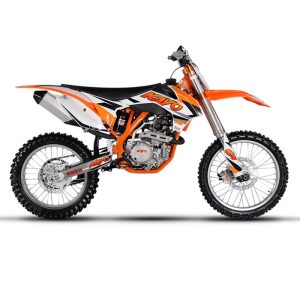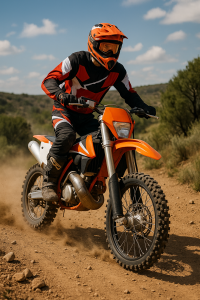Meta Description: Discover how owning a dirt bike transforms your outdoor experience with thrilling rides, cost-saving benefits, and freedom on any terrain.
What is a Dirt Bike?


Dirt bikes are lightweight motorcycles built for off-road terrain like trails, hills, and rugged tracks. Unlike traditional street bikes, they have knobby tires, enhanced suspension, and a frame built to withstand dirt, mud, rocks, and jumps.
History and Evolution of Dirt Bikes
The concept of dirt biking goes back to the early 1900s. British manufacturers like Triumph and BSA were pioneers, creating motorbikes that could navigate rough countryside. In the 1960s and ’70s, Japanese brands like Yamaha and Honda revolutionized the market, introducing lighter and more reliable models. Today, dirt bikes come in electric versions, racing models, and beginner-friendly styles, offering something for everyone.
Key Features That Define a Dirt Bike
- High suspension travel for absorbing shocks from jumps and bumps
- Knobby tires designed for maximum grip on loose or uneven surfaces
- Lightweight frame for improved maneuverability
- Minimal bodywork to reduce weight and make maintenance easier
- High ground clearance for rough terrain
Whether you’re looking to hit a motocross track or explore forest trails, these features make dirt bikes the ultimate adventure machines.
The Freedom of Off-Road Exploration
One of the biggest appeals of owning a dirt bike is the ability to go where regular vehicles can’t.
Accessing Remote Trails
Dirt bikes can take you deep into forests, across deserts, or up mountain trails—places where most cars and trucks would never survive. This opens up endless opportunities for exploration and solitude.
Riding Without Road Restrictions
Unlike street-legal vehicles, dirt bikes allow you to ride on designated off-road trails, private tracks, or rural backroads, often without needing a license or registration (depending on your area). That’s true freedom.
Affordable Fun for All Ages
Compared to other motorsports, dirt biking is surprisingly affordable and accessible.
Budget-Friendly Models
You can find starter dirt bikes for under $1,000, especially if buying used. Maintenance costs are relatively low, and they don’t guzzle gas like cars or ATVs.
Riding as a Family Hobby
There are dirt bikes for every age—from mini 50cc models for kids to powerful 450cc machines for adults. Families often ride together, turning weekends into bonding adventures filled with adrenaline and laughter.
Adrenaline and Physical Fitness
Riding a dirt bike isn’t just fun—it’s also great for your health.
Cardiovascular and Muscle Benefits
Balancing on uneven terrain, handling jumps, and standing while riding all build core strength, improve coordination, and elevate heart rate. It’s a full-body workout without the boredom of the gym.
Mental Focus and Stress Relief
Concentrating on the trail clears your mind of daily stress. Plus, the adrenaline rush from riding boosts endorphins, leaving you happier and more relaxed afterward.
Beginner-Friendly Options
Worried that dirt biking is too intense? Think again.
Electric and Smaller-Engine Models
Electric dirt bikes like the Razor or Sur-Ron models are quieter, easier to maintain, and great for beginners. Gas-powered 110cc or 125cc bikes are ideal for older kids and adults who want to learn gradually.
Safety Features for Starters
Modern dirt bikes often come with throttle limiters, automatic transmissions, and enhanced braking systems—perfect for building confidence as a new rider.
Dirt Bikes vs. ATVs: Why Bikes Win
While ATVs are popular, dirt bikes offer advantages in performance and value.
Maneuverability and Speed
Dirt bikes can navigate narrow paths, make quick turns, and accelerate rapidly—perfect for trail riding or racing. They’re much lighter and more responsive than four-wheelers.
Maintenance and Costs
ATVs tend to be more expensive and require more maintenance. Dirt bikes, especially 2-stroke models, are simpler and cheaper to fix and maintain.
Easy Maintenance and Durability
Don’t worry if you’re not a mechanic—dirt bikes are designed for DIY maintenance.
Simple Mechanics
With fewer parts than a car, most dirt bikes allow easy access to spark plugs, chains, filters, and brakes. Many riders learn to perform basic repairs themselves.
Longevity with Proper Care
Regular oil changes, cleaning the air filter, and proper storage can make your bike last for years—even decades.
Great for Racing and Competitions
If you’ve got a competitive streak, dirt biking opens up a whole new world.
Local Motocross and Enduro Events
Many communities host amateur motocross races and enduro competitions. These are great opportunities to test your skills and meet like-minded enthusiasts.
Building Community and Skill
Participating in races or group rides builds your confidence and technique. You’ll also become part of a community that’s passionate and supportive.
Customization and Upgrades
Make your dirt bike truly yours.
Tires, Exhausts, and Gear
Whether you need better traction, more speed, or a louder engine note, there’s a huge aftermarket of parts. Customize your tires for sand, mud, or rocky trails.
Personalizing Your Ride
Change your plastics, graphics, seat covers, or lighting to match your personality. Your dirt bike should reflect your style and riding goals.
Eco-Friendly Dirt Bike Options
Going green? You can still ride.
Electric Dirt Bikes
Brands like Zero and Sur-Ron offer powerful electric dirt bikes that produce zero emissions and operate quietly—ideal for suburban or forest riding.
Low-Emission Upgrades
Many gas models now offer fuel-injection and low-emission exhaust systems to reduce environmental impact while keeping performance high.
Building Confidence in Riders
Dirt biking helps more than just your muscles—it boosts your mindset.
Overcoming Fear and Challenge
Tackling steep hills, muddy trails, and technical sections helps riders push past fear and self-doubt, teaching resilience and determination.
Skill Growth Over Time
With each ride, you get better. From shifting smoothly to landing jumps, the progress is tangible—and addictive.
Traveling with a Dirt Bike
Taking your bike on the road? Here’s how.
How to Transport Your Bike
Use a pickup truck, hitch-mounted carrier, or trailer. Many dirt bikes are light enough to be lifted by one person with a ramp.
Planning Off-Road Trips
Map out legal trails and campsites in advance. Apps like OnX Offroad or Gaia GPS are perfect for finding new routes and tracking your ride.
Legal Tips and Licensing
Stay legal and safe by knowing the rules.
Where You Can Ride Legally
Check your local and state laws—many areas have designated ORV (Off-Road Vehicle) parks and trail systems. Public land may require permits.
Safety and Registration
Some states require dirt bikes to be registered or carry off-road tags. Always wear a helmet and follow the rules of the trail.
Protective Gear You’ll Need
Safety first—gear up before you go.
Helmets, Gloves, Boots
A good helmet is non-negotiable. Gloves protect your hands, and boots guard your ankles and shins from impacts and heat.
Optional Accessories for Extra Safety
Consider goggles, knee pads, chest protectors, and hydration packs for longer rides or racing conditions.
Common Mistakes New Riders Make
Avoid these beginner blunders.
Avoiding Injury
Don’t skip protective gear, even for a short ride. Learn basic riding posture and braking techniques before hitting advanced trails.
Tips from Seasoned Riders
- Start slow, then build speed
- Learn clutch and throttle control on flat terrain
- Don’t follow others blindly—ride within your skill level
Finding the Right Dirt Bike for You
Choosing the perfect bike can make or break your experience.
Sizing, Engine Types, and Brands
- Kids: 50cc–110cc
- Teens/Adults: 125cc–250cc
- Advanced: 250cc–450cc
Top brands include Honda, Yamaha, KTM, Kawasaki, and Suzuki.
Where to Buy New or Used
Check out local dealerships, Facebook Marketplace, Cycle Trader, or Craigslist. Always inspect used bikes in person or bring a knowledgeable friend.
Community and Culture of Dirt Biking
It’s more than a hobby—it’s a lifestyle.
Local Clubs and Online Groups
From Facebook communities to Reddit threads, riders around the world share tips, stories, and organize group rides.
Events and Meetups
Attend expos, charity rides, and demo days to test new bikes, meet industry pros, and expand your riding network.
FAQs About a Dirt Bike
1. Do I need a license to ride a dirt bike?
Only if you’re riding on public roads. For trails and private land, licenses are usually not required.
2. What’s the best dirt bike for beginners?
Look for a 125cc 4-stroke bike—lightweight, forgiving, and easy to maintain.
3. How often should I change the oil?
Every 10–15 hours of riding or as per the manufacturer’s guide.
4. Can kids ride dirt bikes safely?
Yes, with proper safety gear and supervision. Choose age-appropriate bikes (50cc–110cc).
5. Are electric dirt bikes worth it?
Absolutely. They’re quieter, cleaner, and require less maintenance—great for beginners or urban riders.
6. How much do dirt bikes cost?
New beginner models start around $1,000–$3,000. Premium models can go beyond $10,000.
Conclusion: Why a Dirt Bike is More Than Just a Ride
Owning a dirt bike isn’t just about speed and mud—it’s about adventure, freedom, health, and building a lifelong passion. From weekend rides to competitive races, it opens up a world that’s thrilling, empowering, and endlessly rewarding.
